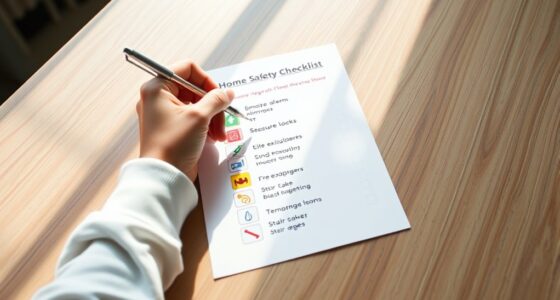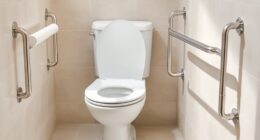To keep seniors safe from fires, make certain you have accessible escape routes with regular drills, and install and maintain smoke alarms with backup batteries and visual alerts. Keep heat sources monitored and clutter-free, and consider home safety features like sprinkler systems and fire-resistant doors. Educate residents and staff on fire safety protocols, and use technology like interconnected alarms and emergency alerts. If you want thorough strategies, there’s more to explore below.
Key Takeaways
- Develop and regularly practice multiple accessible fire escape routes and drills tailored to seniors’ mobility needs.
- Install and maintain smoke alarms, interconnected alarms, and visual/vibration alerts for comprehensive detection.
- Keep pathways clear of clutter, electrical cords, and loose rugs to ensure safe evacuation.
- Educate residents and staff on fire hazards, safety equipment use, and emergency procedures.
- Equip homes with fire-resistant features, accessible exits, and consider sprinkler systems to reduce fire risks.
Assessing and Upgrading Fire Safety Equipment in Senior Homes

To guarantee senior living environments are as safe as possible, it’s vital to regularly assess and upgrade fire safety equipment. Conduct routine safety assessments to verify that emergency exits are unobstructed and that all safety equipment functions correctly. Incorporate local tips and knowledge about city dynamics to better understand how emergency procedures can be optimized for your specific environment. Upgrade your fire safety measures by installing interconnected alarms, which provide coordinated alerts, especially for hearing-impaired seniors with flashing lights or vibrations. Ensure fire extinguishers are accessible, properly charged, and inspected regularly, and that staff know how to use them effectively. Regularly test smoke alarms, replacing batteries twice a year and units every 10 years, to ensure early detection. Additionally, understanding essential oils for safety can be beneficial, as certain oils like tea tree or eucalyptus have antimicrobial properties that support overall health and safety in communal living spaces. Incorporating fire safety technology such as smart sensors and connected alarms can further enhance early warning capabilities. Prioritizing fire prevention through these upgrades helps create a safer environment and minimizes fire risks for residents.
Installing and Maintaining Smoke Alarms and Detectors
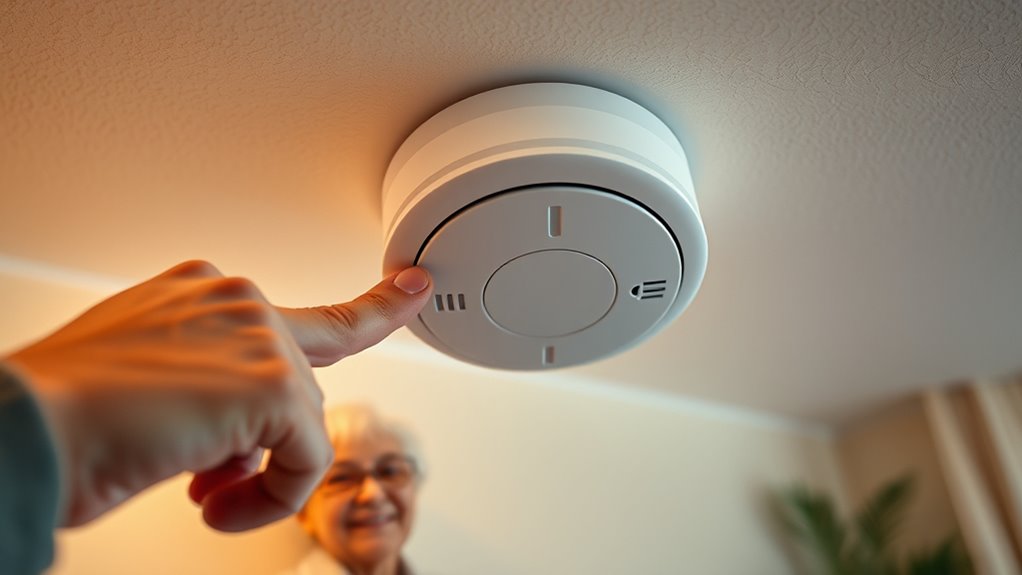
Installing and maintaining smoke alarms is vital for ensuring safety in senior living environments. You should place smoke alarms in every sleeping room, outside each sleeping area, and on every level of your home to guarantee full coverage. Regular testing is essential—test your detectors monthly and replace the batteries at least twice a year to keep them functioning properly. Proper maintenance, including cleaning dust and debris from detectors, can help prevent false alarms and ensure accurate detection. For seniors with hearing impairments, choose alarms with flashing lights or vibration features for effective alerts. Interconnecting multiple alarms ensures that when one detects smoke, all sound simultaneously, providing quicker warnings. This setup can be achieved with wireless options that can be easily interconnected for enhanced safety. Remember to replace smoke alarms every 10 years or sooner if you notice signs of malfunction or wear. Additionally, consider the type of smoke alarm that best suits your needs, such as advanced smoke detection systems that can provide more reliable detection in various environments. Research indicates that properly maintained alarms significantly reduce the risk of fire-related injuries and fatalities in senior living areas. Properly installing smoke detectors in optimal locations ensures maximum effectiveness. In regions with extensive waterpark resorts, installing extensive safety measures can provide additional safety for large facilities.
Creating Effective Escape Plans Tailored for Seniors

You should develop and regularly practice multiple escape routes that are accessible and free of obstructions. Make sure your plan considers your mobility and sensory needs, like having portable ladders or keeping essential items nearby. Consistently rehearse these routes with everyone in your household to ensure quick, confident evacuation in an emergency. Incorporating self watering plant pots can further enhance your preparedness and reduce risks during an emergency. Additionally, understanding how juice detox side effects can impact your energy levels may help you better prepare for stressful situations like emergencies. Research shows that security systems can increase safety and provide peace of mind during such critical moments. Exploring personality traits can also help you remain calm and focused under stress, improving your response during an emergency.
Multiple Escape Routes Practice
Creating effective escape plans for seniors involves developing at least two clearly marked escape routes from each room and practicing them regularly. You should conduct fire drills twice a year to ensure familiarity and reinforce safety measures. Make sure your escape routes remain unobstructed and easily accessible, especially during emergencies. Tailor your evacuation plan to accommodate mobility aids, sight, or hearing impairments, so everyone can evacuate quickly. Keep essential items like glasses, phones, and hearing aids nearby and ready to grab. For multi-story homes, consider sleeping on the ground floor or installing accessible escape ladders for upper floors. Regular practice helps identify and resolve any obstructions or issues, ensuring your senior safety is always a priority during an emergency. Emergency preparedness is essential to ensure that every member of your household knows how to respond swiftly and safely. Additionally, understanding fire safety protocols can significantly improve response times and safety during an incident. Incorporating hydrogen safety measures, such as proper storage and detection systems, can further enhance overall safety in case of emergencies. Being aware of crypto market trends can also help in making informed decisions during financial emergencies, ensuring peace of mind in unpredictable situations.
Accessibility and Mobility Needs
Designing escape plans that prioritize accessibility and mobility needs guarantees seniors can evacuate quickly and safely. Assure each room has at least two accessible exits, considering mobility aids like wheelchairs or walkers. For upper floors, sleep on the ground floor or install escape ladders to facilitate quick evacuation. Keep essential items—glasses, hearing aids, phones—within reach. Test door handles and window latches regularly to confirm they’re easy to operate. Practice escape drills tailored to mobility limitations, building confidence and familiarity. Incorporate clear signage and visual cues to guide residents during an emergency. Use this table to identify key features:
| Feature | Consideration |
|---|---|
| Accessible Exits | Ensure multiple, easy-to-reach escape routes |
| Door Handles & Latches | Easy-to-operate, tested regularly |
| Escape Routes | Clear, unobstructed paths from all rooms |
| Escape Plan | Incorporate mobility aids and ground floor options |
Clear, Unobstructed Pathways
Ensuring escape routes are free of clutter and obstacles is essential for seniors to evacuate quickly and safely during emergencies. Unobstructed pathways allow for a clear passage to fire exits, reducing the risk of falls and delays. Incorporating modern safety standards into your home can further enhance evacuation preparedness. Keep hallways, stairwells, and doorways well-lit and free of safety hazards like electrical cords, loose rugs, or furniture. Regularly inspect and maintain door hinges, locks, and thresholds to guarantee they open easily. During fire drills, emphasize moving swiftly along these clear routes to reinforce their importance. Removing tripping hazards and securing loose carpeting helps prevent falls during evacuation and supports fire safety protocols. Conducting a home safety assessment can help identify potential problem areas and improve overall safety measures. Additionally, understanding fire behavior can assist in planning effective escape strategies tailored for seniors.
Implementing Fire Prevention Strategies for Older Adults

Implementing fire prevention strategies for older adults involves proactive measures that considerably reduce the risk of fires and enhance safety. Start by regularly inspecting and maintaining smoke alarms, batteries, and sprinkler systems—remember, about 95% of homes lack sprinklers, which can cut fire death risk by 80%. Keep fire hazards like paper and cloth away from heat sources such as stoves and fireplaces. Never leave cooking unattended or smoke and candles lit unsupervised. Installing fire-resistant features, including fireproof doors and accessible emergency exits, boosts home safety. Conduct routine fire drills tailored to mobility and sensory needs, so you’re prepared to act swiftly. Keep fire extinguishers accessible and know how to use them. Incorporating data-driven strategies can help identify and mitigate potential fire risks more effectively. Additionally, understanding the role of creative practice in developing innovative safety solutions can lead to more effective prevention measures. Recognizing the importance of cybersecurity vulnerabilities in home safety systems ensures that technological devices remain protected from hacking attempts, which could otherwise compromise safety. These steps create a safer environment and promote effective fire prevention for seniors.
The Role of Sprinkler Systems and Home Safety Features

Sprinkler systems and home safety features play a vital role in protecting seniors from fire hazards. Fire sprinkler systems can reduce the risk of death by 80% and contain fires in the origin room 97% of the time, making them indispensable for senior safety.
Many older homes lack these fire suppression systems, increasing fire risks. Installing or retrofitting sprinkler systems is a cost-effective way to enhance home safety, especially for those with mobility or health issues.
Fire detection devices, combined with sprinkler systems, improve early warning and fire prevention. Although the cost varies, investing in fire sprinkler systems offers significant peace of mind and can save lives.
Upgrading home safety features ensures quicker fire suppression and better protection for vulnerable seniors.
Ensuring Safe Cooking and Heating Practices

To prevent kitchen fires and burns, it’s crucial to practice safe cooking and heating habits. In senior living, fire safety starts with never leaving cooking unattended, especially on stovetops or in ovens, to reduce fire hazards.
Keep flammable items like dish towels and paper nearby away from hot surfaces and open flames.
Keep flammable items like dish towels and paper away from hot surfaces and open flames.
When frying with hot oil, exercise caution; never add water to grease fires—smother them with a lid or fire extinguisher instead.
Set your water heater to a maximum of 110°F to prevent scald burns.
Use heating equipment, like electric blankets with safety features, and avoid space heaters near combustible materials.
Regularly check smoke alarms to ensure home safety, and stay vigilant to minimize fire risks and promote effective fire prevention.
Conducting Regular Fire Drills and Emergency Preparedness Exercises
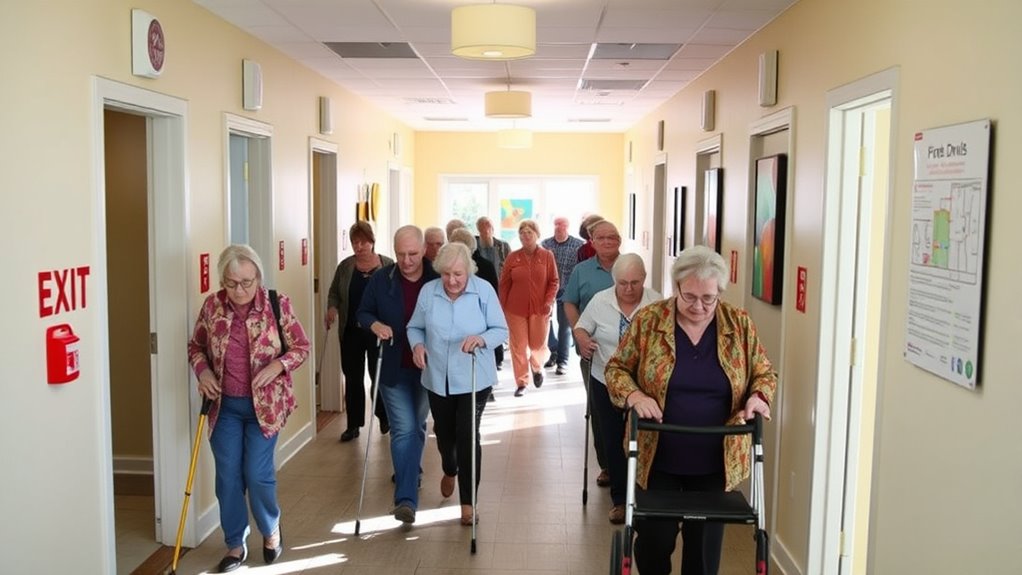
Regular fire drills help you stay prepared by practicing escape routes and ensuring everyone knows what to do.
Make sure to assign assistance roles clearly so help is available if needed, and check smoke alarms regularly to confirm they work.
Vary the times of your drills to simulate real emergencies and improve your overall safety readiness.
Practice Escape Routes Frequently
Practicing fire escape routes at least twice a year is essential for seniors to respond quickly and confidently during emergencies. Regular fire drills help verify that your fire escape plans are effective and that escape routes remain clear of obstacles.
Incorporating evacuation practice into your safety routines ensures you’re familiar with two or more escape routes, reducing evacuation time during a real fire—crucial since most seniors aim to escape within three minutes. Tailoring emergency procedures to your mobility needs, such as ground-floor bedrooms or stairway ladders, enhances safety.
Rehearsing these fire safety preparedness steps with household members also guarantees everyone understands their roles. Consistent practice improves your confidence, making senior safety a seamless part of your emergency procedures.
Assign Assistance Roles Clearly
Assigning clear assistance roles is vital for a smooth and effective fire response. When you conduct fire drills and emergency preparedness exercises, everyone understands their safety responsibilities and how to act swiftly.
Assign specific assistance roles to household members or caregivers, so every person knows their part during an emergency. Regularly practice fire drills to verify that escape routes are accessible and everyone is familiar with fire safety procedures.
Establish backup helpers in case primary assistance roles are unavailable, ensuring your emergency plans remain effective. Clear communication and documentation of each person’s assistance responsibilities help prevent confusion.
Verify Alarm Functionality Regularly
Ensuring everyone knows their roles during a fire is important, but it’s equally essential to confirm that your alarm systems work properly. Regularly testing smoke alarms is vital for fire safety, as it guarantees the alarms’ functionality and early warning capabilities.
You should test all alarms monthly and replace batteries twice a year to keep them reliable. During fire drills, simulate emergency scenarios to evaluate response times and identify areas for improvement.
Incorporate alarms with visual or vibration alerts for seniors with hearing impairments, guaranteeing everyone is alerted promptly. Document and review each drill, checking that alarms sound correctly and respond as expected.
Regular checks of smoke alarms help maintain the integrity of your fire safety plan and protect everyone in the household.
Educating Residents and Staff on Fire Safety Protocols
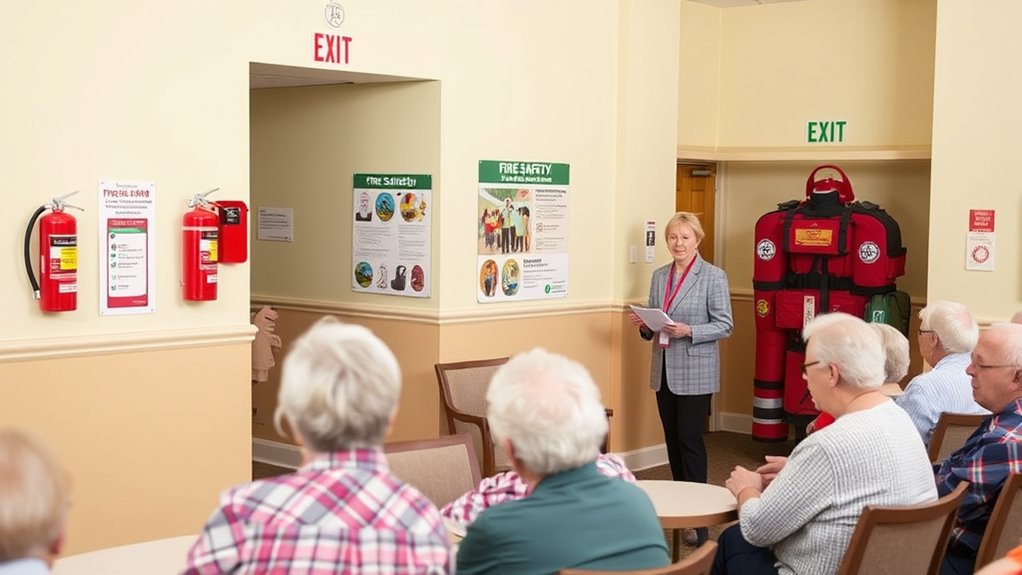
Educating residents and staff on fire safety protocols is essential to prevent fires and protect lives in senior living communities. When everyone understands safety protocols, hazards are recognized early, and responses are swift.
Educating staff and residents on fire safety is vital for early hazard recognition and swift response.
Regular fire drills help residents become familiar with evacuation routes, reducing escape times to under three minutes. Staff training ensures quick, organized evacuations, especially for residents with mobility or hearing impairments.
Teaching residents how to properly use fire extinguishers and emergency alarms can stop small fires from spreading. Building safety also depends on ongoing education about fire safety measures.
Collaboration with fire and EMS professionals enhances awareness of emergency procedures tailored for seniors, ensuring everyone knows how to act confidently during a fire emergency.
- Conduct routine fire drills to improve evacuation efficiency
- Train staff on building safety, emergency alarms, and fire extinguishers
- Educate residents on hazards and proper use of safety equipment
- Reinforce the importance of quick, organized evacuation procedures
Utilizing Technology and Resources to Enhance Fire Safety

Implementing advanced technology and resources can substantially strengthen fire safety in senior living communities. Smart home technology, like automated sprinkler systems and remotely monitored fire alarm systems, can detect fires early and reduce injuries. Fire safety devices with flashing lights or vibrations improve alert accuracy for those with hearing impairments. Emergency alert apps and phone systems quickly notify residents and fire services, speeding up responses. Fire prevention education, including printed materials and online training through programs like “Steps to Safety,” empowers seniors to recognize risks and escape effectively. Regular maintenance of fire safety devices ensures ideal performance. Use the following table to visualize integrated fire safety tools:
| Technology/Resource | Function |
|---|---|
| Smart home tech | Fire detection and automatic suppression |
| Emergency alert apps | Rapid notification to residents and services |
| Fire safety resources | Education and preparedness support |
Frequently Asked Questions
What Can Older Adults Do to Prevent Fires?
To prevent fires, you should never leave your stove unattended while cooking, as it’s a common cause of home fires.
Avoid smoking in bed or when drowsy, and keep flammable items like towels away from heat sources.
Install and test smoke alarms regularly, and store matches and lighters out of reach.
These simple steps help you stay safe and reduce your risk of fire accidents.
What Are the 4 P’s of Fire Safety?
You should know the 4 P’s of fire safety: prevent, prepare, protect, and participate. Prevent means avoiding fire hazards with safe habits.
Prepare involves creating and practicing escape plans suited to your home and needs.
Protect focuses on installing and maintaining safety devices like smoke alarms and extinguishers.
Participate encourages engaging with your community through drills and safety programs.
Following these steps helps keep you safe and prepared in case of a fire.
What Are the 10 Fire Safety Tips?
Did you know that most home fires start in the kitchen? To stay safe, install smoke alarms in every bedroom and on each floor, test them monthly, and replace batteries twice a year.
Keep escape routes clear, never leave cooking unattended, and use battery-operated candles.
Keep fire extinguishers nearby and practice two escape plans regularly.
Staying vigilant and prepared reduces fire risks and keeps you safe in emergencies.
What Are the 5 E’s of Fire Prevention?
The 5 E’s of fire prevention are Education, Engineering, Enforcement, Emergency response, and Evacuation planning.
You can improve safety by learning about fire hazards and practicing fire drills.
Install smoke alarms, sprinklers, and guarantee wiring is safe.
Follow fire safety rules and codes.
Be prepared to respond quickly if a fire occurs, and have a clear evacuation plan in place so you can get out safely and swiftly.
Conclusion
By taking these fire safety tips to heart, you create a shield around your loved ones like a sturdy fortress. Regularly assess equipment, practice escape plans, and stay informed to turn potential hazards into safe havens. Remember, fire safety isn’t a one-time effort but a continuous journey—each step you take is a brick in building a safer, more secure home for seniors. Together, you’re lighting the way to peace of mind.





